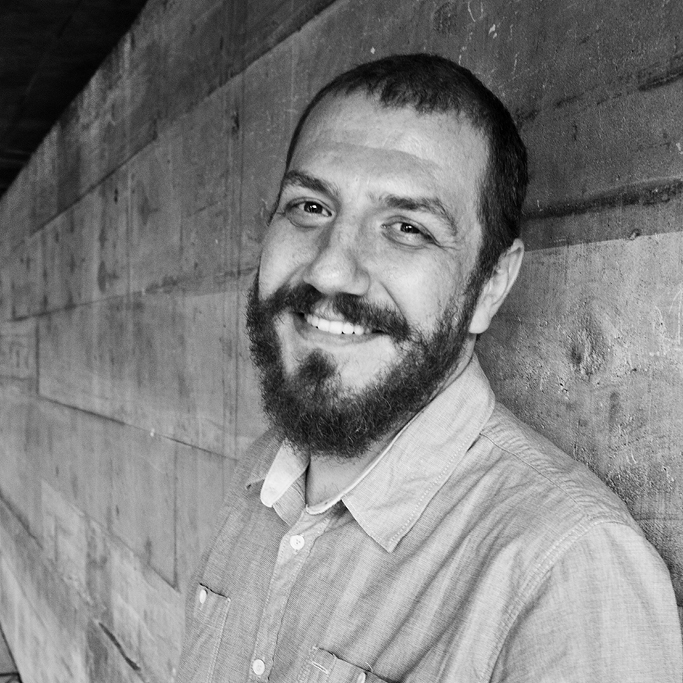You are here
by Cauê Alves
The phrase Você está aqui / You are here, title of this exhibition, is generally found on maps and in locating systems as an indication of a specific location within a larger scheme. However, this statement taken out of a reference frame or cartography loses entirely its function of indicating a position. Here indicates this space which you occupy, the place where the exhibition is happening, and it presupposes a given moment. In a broader sense, even if the ‘here’ isn’t fixed, we are always here in relation to ourselves.
Raul Mourão’s exhibition which is happening here at MuBE (Brazilian Museum of Sculpture and Ecology) also highlights this place. The show interacts with the architecture of the museum and its spaces. The ramp, the different levels of the floor in the main room, and the marquee of the external area, all integrate with the artist’s work.
The raw materials of the works are modular structures, a kind of geometric skeleton used in civil construction. The process of assembling the sculptures takes place here in the museum, in accordance with a previously elaborated plan. All the works are made from bars, clamps and elementary thinking: a rational and simple constructing system that allows an almost instantaneous appearance of enormous structures in the landscape. And they can be dismantled just as quickly. They are pop-up structures that jump out like images from children’s books.
There is indeed a ludic aspect to Raul Mourão’s pieces. They dance and totter like drunkards from one side to the other. But instead of being on a tightrope, some of the forms conceived by the artist seem to be performing on parallel bars. Maybe they are gymnasts spinning with the lightness of athletes only without keeping an upright posture. Although their movements on the bars aren’t rehearsed, they never fall to the ground. The maneuvers of the cubes and cobblestones on the horizontal bars are like Olympic performances, with handstands, swings and near death somersaults. But the motion of the pieces require the visitor’s interaction, swinging the iron tubes in rhythms that will vary depending on the strength put on them. As a result of the friction, the movement slowly decreases until it stops completely.
The works are lessons in spatial geometry. Each circular bar rests on a single point of the other, even while they are in movement. The volumes are enmeshed with each other, with areas that intersect. They communicate through movements, which will vary depending on the angles chosen by the artist, the number of bars and the differences in the mass of the empty solids.
The large work in the external area behaves as if it were flirting with architecture, through movements of approaching and retreating from the marquee of the MuBE. If the work sometimes seems to threaten the integrity of the building, it soon shows itself to be kind, as if it were courting the building. The works are, in fact, attractive. They use the vocabulary of civil construction and interact directly with the architecture of Paulo Mendes da Rocha. In general, Raul Mourão’s sculptures evoke spontaneousness and provoke a relaxed and unpretentious response of the visitor’s body.
The rhythmical movement and poise of the sculptures amuse the public, capturing its gaze without failing to raise questions. Is the exhibition ready? The unfinished appearance and transparency of the pieces are important in calling attention to the construction process, to the process of becoming. Indeed, works of art, like museums, are never ready or finished. On the contrary, they are open, provisional and endless, always subject to other interpretations and meanings that are yet to emerge. Not simply because they await the gaze and touch of different audiences, but because they are in the process of transformation, acquiring new meanings with the passing of time.
These works by Raul Mourão are in complete harmony with the plan for the collection that is being implanted at MuBE. Rather than being a place that simply houses works, the museum is seeking to acquire the right to carry out projects created by the artists themselves. Thus, the documenting and recording of past shows must be registered in order that it can be propagated and carried out again in the future without the need for the artist’s physical presence. More than simply conserving the materiality of a work, the idea is to understand the project and its variables. Rather than a collection of objects, the museum houses, studies and sets up works conceived by artists as ephemeral assembled for the exhibitions and then dismantled. Hence the importance of the descriptive memorandum, statements, technical and conceptual information for their execution. The artist’s conceptions and ideas are more important than the steel bars and clamps that compose his work, since these can be rented out and subsequently returned to their owners. Then the ideas need to be registered so that they can eventually give life to materials available in the future, should these bars cease to be manufactured.
The modular structures used in the major engineering projects may suggest to the uninformed viewer that the museum is undergoing restoration. And although the MuBE is well preserved, conceptually speaking it is being revitalized; it is under renovation. Recently, in addition to a curator, the museum has acquired a new manager, associates and board members. The museum’s statute has been revised. We have produced a new museological plan and a new classification system for exhibitions that it is more consistent with the aim of building a more dynamic museum. Raul Mourão’s exhibition is part of this new MuBE and is helping to build a new relationship between art, architecture and the urban landscape, highlighting the place where we are: here.
